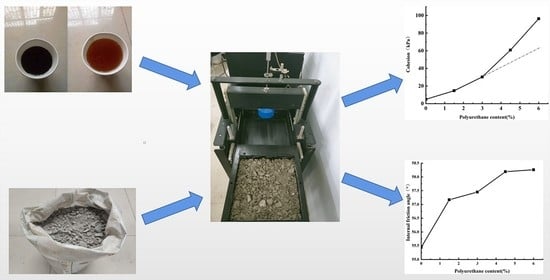Analysis of Shear Resistance and Mechanism of Construction and Demolition Waste Improved by Polyurethane
Abstract
:1. Introduction
2. Materials and Experimental Program
2.1. Materials
2.2. Test Equipments
2.3. Test Process
2.3.1. Samples Preparation for Large-Scale Direct Shear Test
2.3.2. Samples Preparation for CBR Test
2.3.3. Samples Preparation for Microscopic Test
3. Laboratory Results and Discussions
3.1. Large-Scale Direct Shear Test Results and Analysis
3.1.1. The Influence of Vertical Load on the Shear Strength of CDW
3.1.2. The Influence of Polyurethane Content on the Shear Strength of CDW
3.1.3. The Influence of Shear Rate on the Shear Strength of CDW
3.1.4. The Influence of Polyurethane Content on the Cohesion and Internal Friction Angle of CDW
3.2. California Bearing Ratio (CBR) Test Results and Analysis
3.3. Microscopic Analysis
4. Conclusions
Author Contributions
Funding
Data Availability Statement
Conflicts of Interest
References
- Arulrajah, A.; Disfani, M.M.; Horpibulsuk, S.; Suksiripattanapong, C.; Prongmanee, N. Physical properties and shear strength responses of recycled construction and demolition materials in unbound pavement base/subbase applications. Constr. Build. Mater. 2014, 58, 245–257. [Google Scholar] [CrossRef]
- Li, Z.; Yang, J.; Liu, L.; Yan, S. Evaluating the creep characteristics of recycled construction waste materials under saturated and dry condition. Arab. J. Geosci. 2021, 14, 153. [Google Scholar] [CrossRef]
- Hu, Z.; Kong, Z.; Cai, G.; Li, Q.; Guo, Y.; Su, D.; Liu, J.; Zheng, S. Study of the Properties of Full Component Recycled Dry-Mixed Masonry Mortar and Concrete Prepared from Construction Solid Waste. Sustainability 2021, 13, 8385. [Google Scholar] [CrossRef]
- Tang, Q.; Ma, Z.; Wu, H.; Wang, W. The utilization of eco-friendly recycled powder from concrete and brick waste in new concrete: A critical review. Cem. Concr. Compos. 2020, 114, 103807. [Google Scholar] [CrossRef]
- Lu, W. Big data analytics to identify illegal construction waste dumping: A Hong Kong study. Resour. Conserv. Recycl. 2018, 141, 264–272. [Google Scholar] [CrossRef]
- Guerra, B.C.; Bakchan, A.; Leite, F.; Faust, K.M. BIM-based automated construction waste estimation algorithms: The case of concrete and drywall waste streams. Waste Manag. 2019, 87, 825–832. [Google Scholar] [CrossRef]
- Wu, H.; Zuo, J.; Zillante, G.; Wang, J.; Yuan, H. Status quo and future directions of construction and demolition waste research: A critical review. J. Clean. Prod. 2019, 240, 118163. [Google Scholar] [CrossRef]
- Seror, N.; Portnov, B.A. Estimating the effectiveness of different environmental law enforcement policies on illegal C&D waste dumping in Israel. Waste Manag. 2019, 102, 241–248. [Google Scholar] [CrossRef]
- Xiao, J.; Ma, Z.; Ding, T. Reclamation chain of waste concrete: A case study of Shanghai. Waste Manag. 2016, 48, 334–343. [Google Scholar] [CrossRef]
- Barbudo, A.; Agrela, F.; Ayuso, J.; Jiménez, J.R.; Poon, C.S. Statistical analysis of recycled aggregates derived from different sources for sub-base applications. Constr. Build. Mater. 2012, 28, 129–138. [Google Scholar] [CrossRef]
- Dolan, P.J.; Lampo, R.G.; Dearborn, J.C. Concepts For Reuse And Recycling Of Construction And Demolition Waste; Construction Engineering Research Lab (Army): Champaign, IL, USA, 1999. [Google Scholar]
- Arulrajah, A.; Piratheepan, J.; Bo, M.W.; Sivakugan, N. Geotechnical characteristics of recycled crushed brick blends for pavement sub-base applications. Can. Geotech. J. 2012, 49, 796–811. [Google Scholar] [CrossRef]
- Tavira, J.; Jiménez, J.R.; Ayuso, J.; Sierra, M.J.; Ledesma, E.F. Functional and structural parameters of a paved road section constructed with mixed recycled aggregates from non-selected construction and demolition waste with excavation soil. Constr. Build. Mater. 2018, 164, 57–69. [Google Scholar] [CrossRef]
- Cabalar, A.; Zardikawi, O.; Abdulnafaa, M. Utilisation of construction and demolition materials with clay for road pavement subgrade. Road Mater. Pavement Des. 2017, 20, 702–714. [Google Scholar] [CrossRef]
- Leite, F.D.C.; Motta, R.; Vasconcelos, K.L.; Bernucci, L. Laboratory evaluation of recycled construction and demolition waste for pavements. Constr. Build. Mater. 2011, 25, 2972–2979. [Google Scholar] [CrossRef]
- Rahman, M.A.; Arulrajah, A.; Piratheepan, J.; Bo, M.W.; Imteaz, M.A. Resilient Modulus and Permanent Deformation Responses of Geogrid-Reinforced Construction and Demolition Materials. J. Mater. Civ. Eng. 2014, 26, 512–519. [Google Scholar] [CrossRef]
- Rahman, A.; Imteaz, M.; Arulrajah, A.; Disfani, M.M. Suitability of recycled construction and demolition aggregates as alternative pipe backfilling materials. J. Clean. Prod. 2014, 66, 75–84. [Google Scholar] [CrossRef]
- Mohammadinia, A.; Arulrajah, A.; Horpibulsuk, S.; Shourijeh, P.T. Impact of potassium cations on the light chemical stabilization of construction and demolition wastes. Constr. Build. Mater. 2019, 203, 69–74. [Google Scholar] [CrossRef]
- Kianimehr, M.; Shourijeh, P.T.; Binesh, S.M.; Mohammadinia, A.; Arulrajah, A. Utilization of recycled concrete aggregates for light-stabilization of clay soils. Constr. Build. Mater. 2019, 227, 116792. [Google Scholar] [CrossRef]
- Agrela, F.; Barbudo, A.; Ramírez, A.; Ayuso, J.; Carvajal, M.D.; Jiménez, J.R. Construction of road sections using mixed recycled aggregates treated with cement in Malaga, Spain. Resour. Conserv. Recycl. 2012, 58, 98–106. [Google Scholar] [CrossRef]
- Mohammadinia, A.; Arulrajah, A.; Sanjayan, J.; Disfani, M.M.; Bo, M.W.; Darmawan, S. Laboratory Evaluation of the Use of Cement-Treated Construction and Demolition Materials in Pavement Base and Subbase Applications. J. Mater. Civ. Eng. 2015, 27, 04014186. [Google Scholar] [CrossRef]
- Cristelo, N.; Jimenez, A.M.F.; Vieira, C.; Miranda, T.; Palomo, Á. Stabilisation of construction and demolition waste with a high fines content using alkali activated fly ash. Constr. Build. Mater. 2018, 170, 26–39. [Google Scholar] [CrossRef]
- Sharma, R.K.; Hymavathi, J. Effect of fly ash, construction demolition waste and lime on geotechnical characteristics of a clayey soil: A comparative study. Environ. Earth Sci. 2016, 75, 377. [Google Scholar] [CrossRef]
- Arulrajah, A.; Mohammadinia, A.; Horpibulsuk, S.; Samingthong, W. Influence of class F fly ash and curing temperature on strength development of fly ash-recycled concrete aggregate blends. Constr. Build. Mater. 2016, 127, 743–750. [Google Scholar] [CrossRef]
- Javadi, A.S.; Badiee, H.; Sabermahani, M. Mechanical properties and durability of bio-blocks with recycled concrete aggregates. Constr. Build. Mater. 2018, 165, 859–865. [Google Scholar] [CrossRef]
- Qiu, J.; Xiang, J.; Zhang, W.; Zhao, Y.; Sun, X.; Gu, X. Effect of microbial-cemented on mechanical properties of iron tailings backfill and its mechanism analysis. Constr. Build. Mater. 2021, 318, 126001. [Google Scholar] [CrossRef]
- Somarathna, H.; Raman, S.; Mohotti, D.; Mutalib, A.; Badri, K. The use of polyurethane for structural and infrastructural engineering applications: A state-of-the-art review. Constr. Build. Mater. 2018, 190, 995–1014. [Google Scholar] [CrossRef]
- Xiao, Y.; Liu, H.; Desai, C.S. New Method for Improvement of Rockfill Material with Polyurethane Foam Adhesive. J. Geotech. Geoenviron. Eng. 2015, 141, 02814003. [Google Scholar] [CrossRef]
- Ma, W.; Zhao, Z.; Guo, S.; Zhao, Y.; Wu, Z.; Yang, C. Performance Evaluation of the Polyurethane-Based Composites Prepared with Recycled Polymer Concrete Aggregate. Materials 2020, 13, 616. [Google Scholar] [CrossRef] [Green Version]
- Buzzi, O.; Fityus, S.; Sloan, S. Use of expanding polyurethane resin to remediate expansive soil foundations. Can. Geotech. J. 2010, 47, 623–634. [Google Scholar] [CrossRef] [Green Version]
- Buzzi, O.; Fityus, S.; Sasaki, Y.; Sloan, S. Structure and properties of expanding polyurethane foam in the context of foundation remediation in expansive soil. Mech. Mater. 2008, 40, 1012–1021. [Google Scholar] [CrossRef]
- Ma, Q.; Chen, J.-F.; Xiao, H.-L.; Pan, Y.-T.; Song, Z.-N. Effect of polyurethane foam adhesive on the static mechanical properties of municipal solid waste incineration bottom ash (IBA). Constr. Build. Mater. 2022, 325, 126460. [Google Scholar] [CrossRef]
- Chen, Q.; Yu, R.; Li, Y.; Tao, G.; Nimbalkar, S. Cyclic stress-strain characteristics of calcareous sand improved by polyurethane foam adhesive. Transp. Geotech. 2021, 31, 100640. [Google Scholar] [CrossRef]
- Lee, S.H.; Lee, S.J.; Park, J.G.; Choi, Y.-T. An experimental study on the characteristics of polyurethane-mixed coarse aggregates by large-scale triaxial test. Constr. Build. Mater. 2017, 145, 117–125. [Google Scholar] [CrossRef]
- ASTM D2487-06; Standard Practice for Classification of Soils for Engineering Purposes (Unified Soil Classification System). ASTM: West Conshohocken, PA, USA, 2006.
- Infante, D.J.U.; Martinez, G.M.A.; Arrua, P.A.; Eberhardt, M. Shear Strength Behavior of Different Geosynthetic Reinforced Soil Structure from Direct Shear Test. Int. J. Geosynth. Ground Eng. 2016, 2, 17. [Google Scholar] [CrossRef] [Green Version]

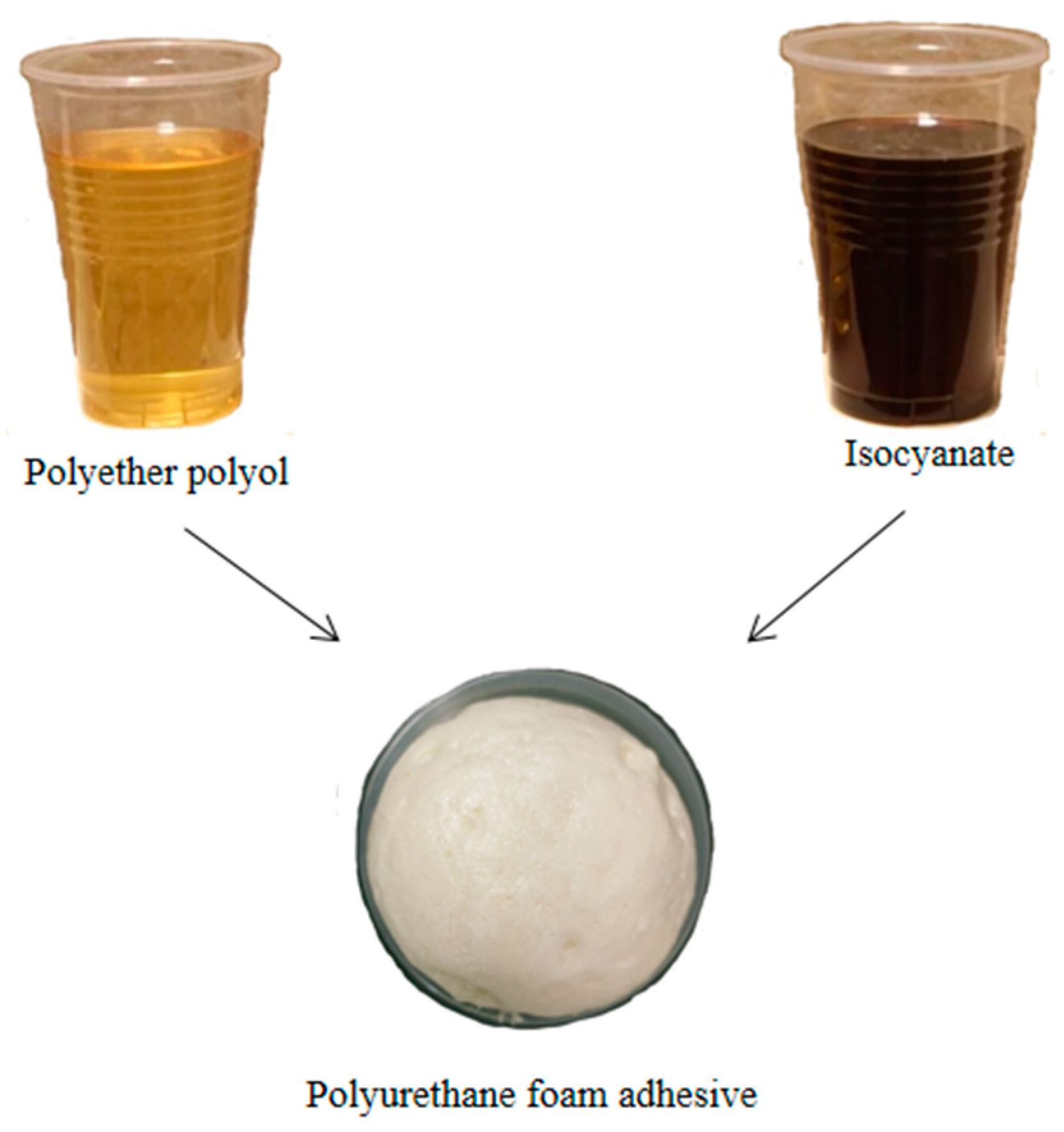
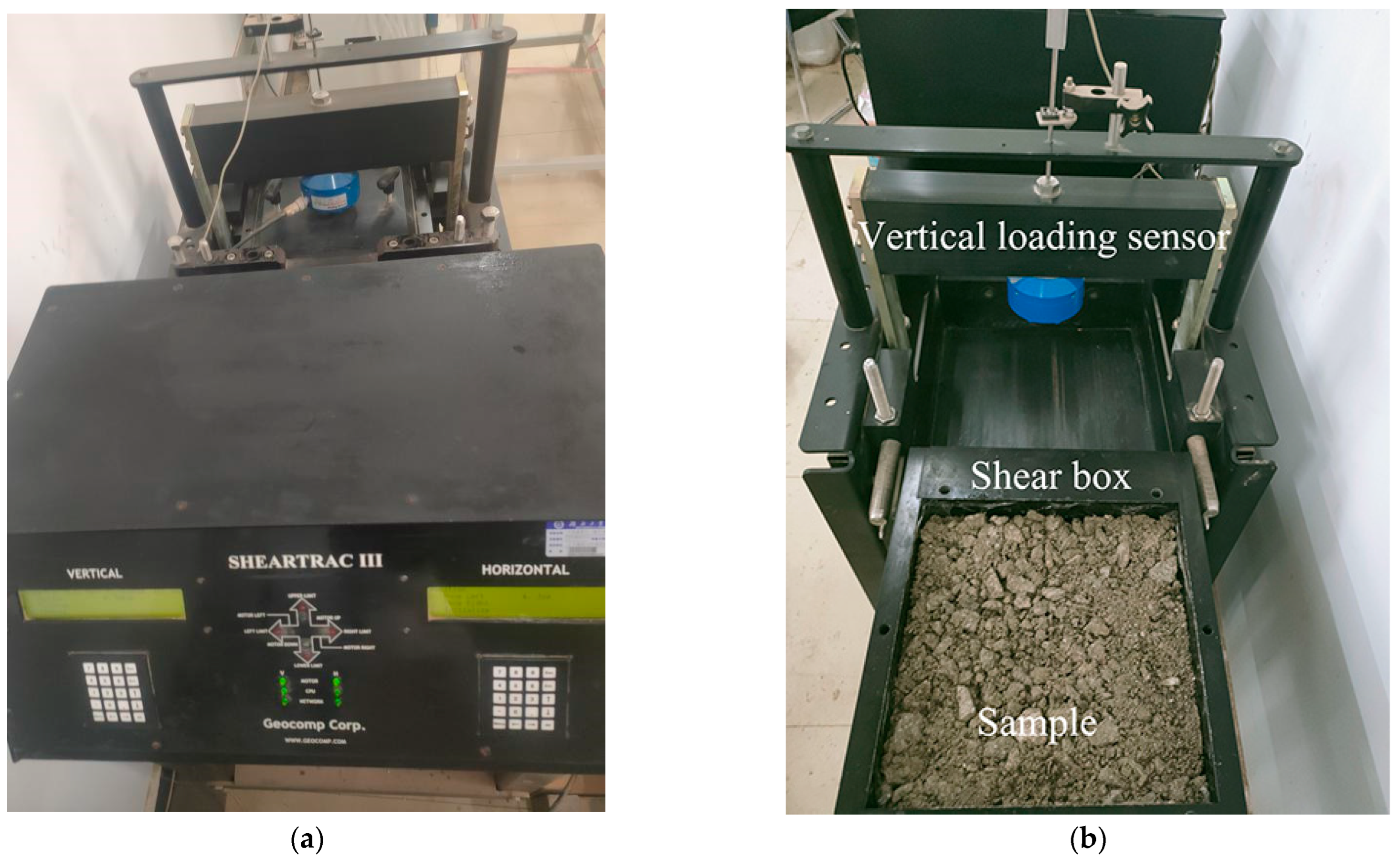


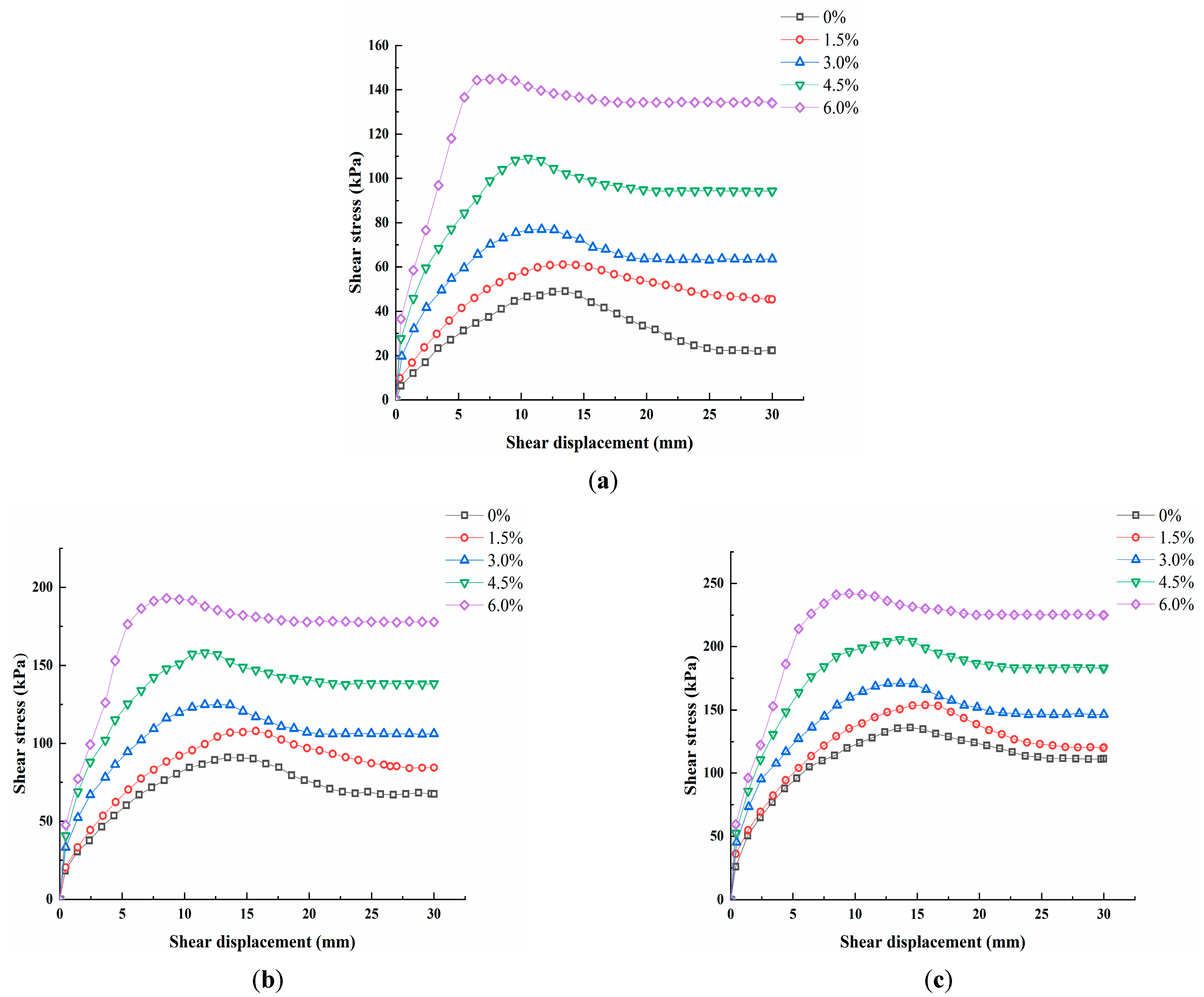
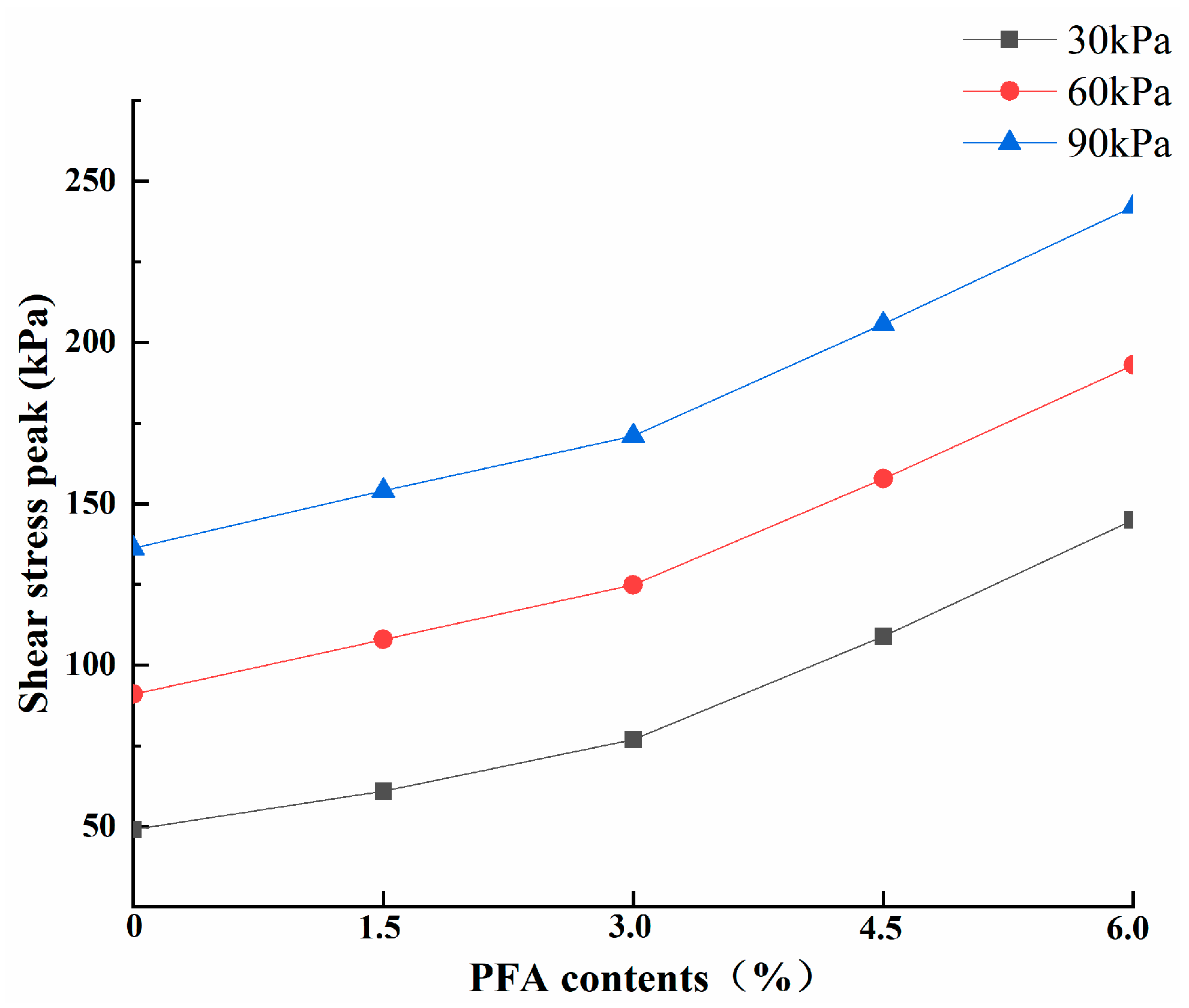

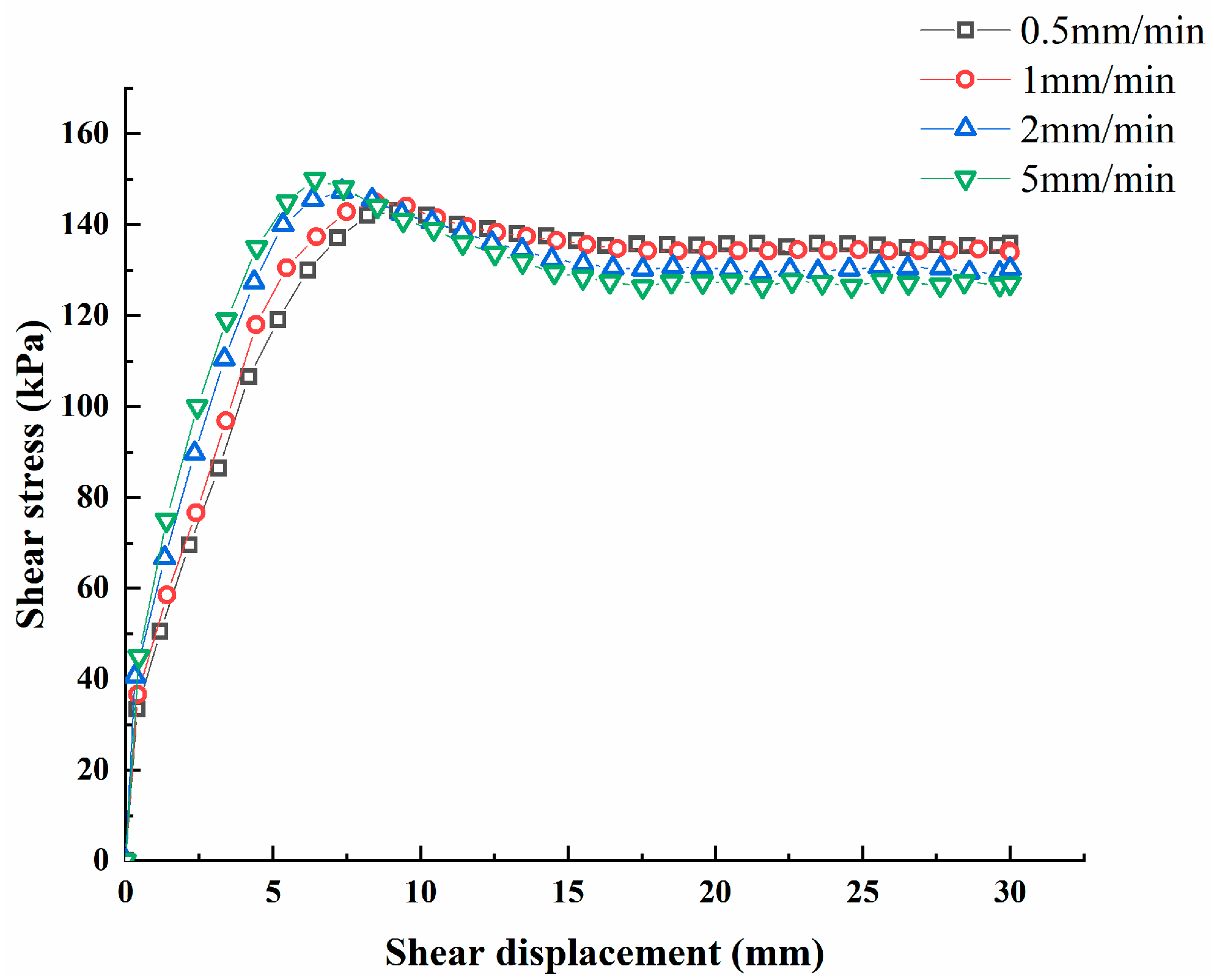


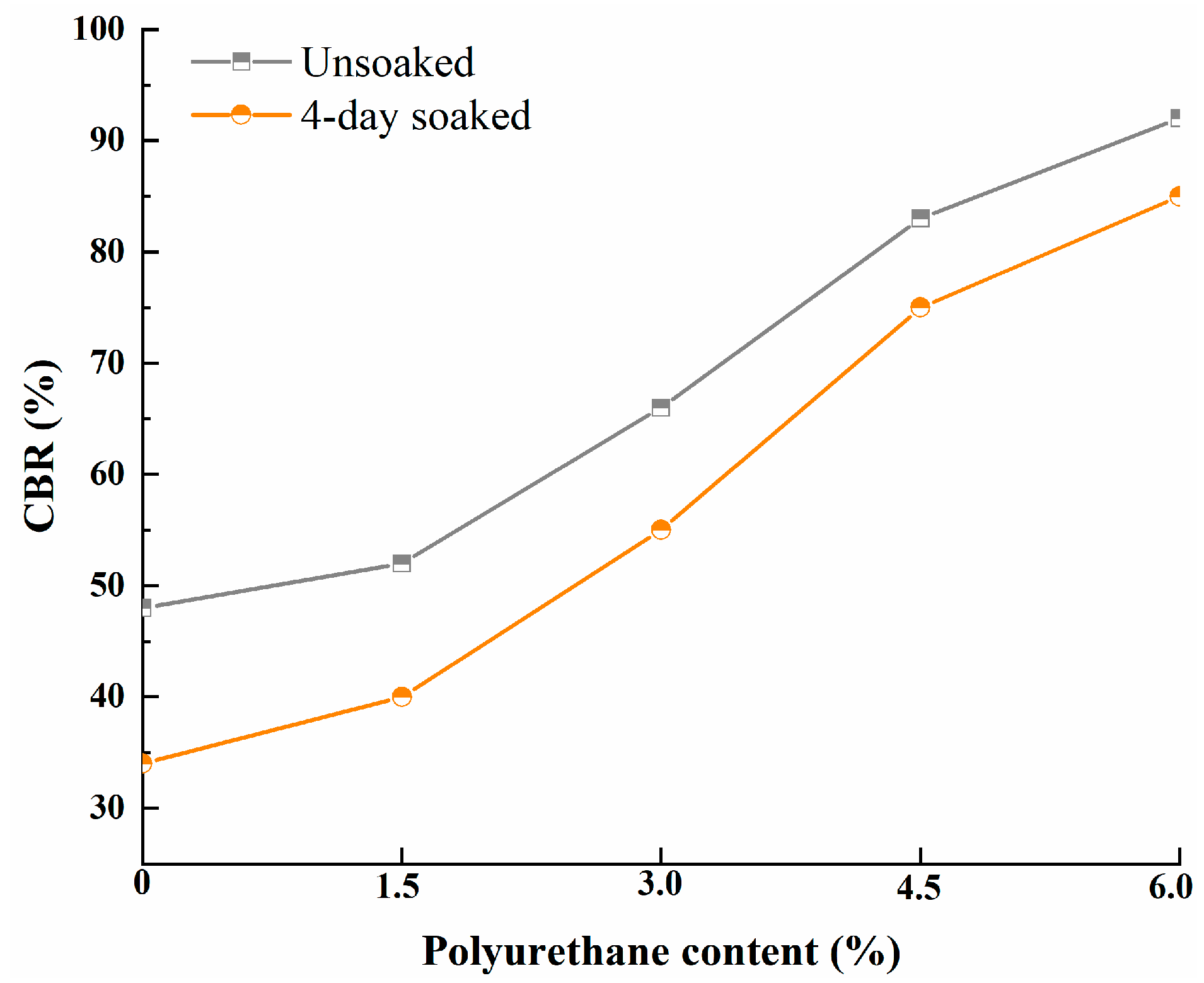
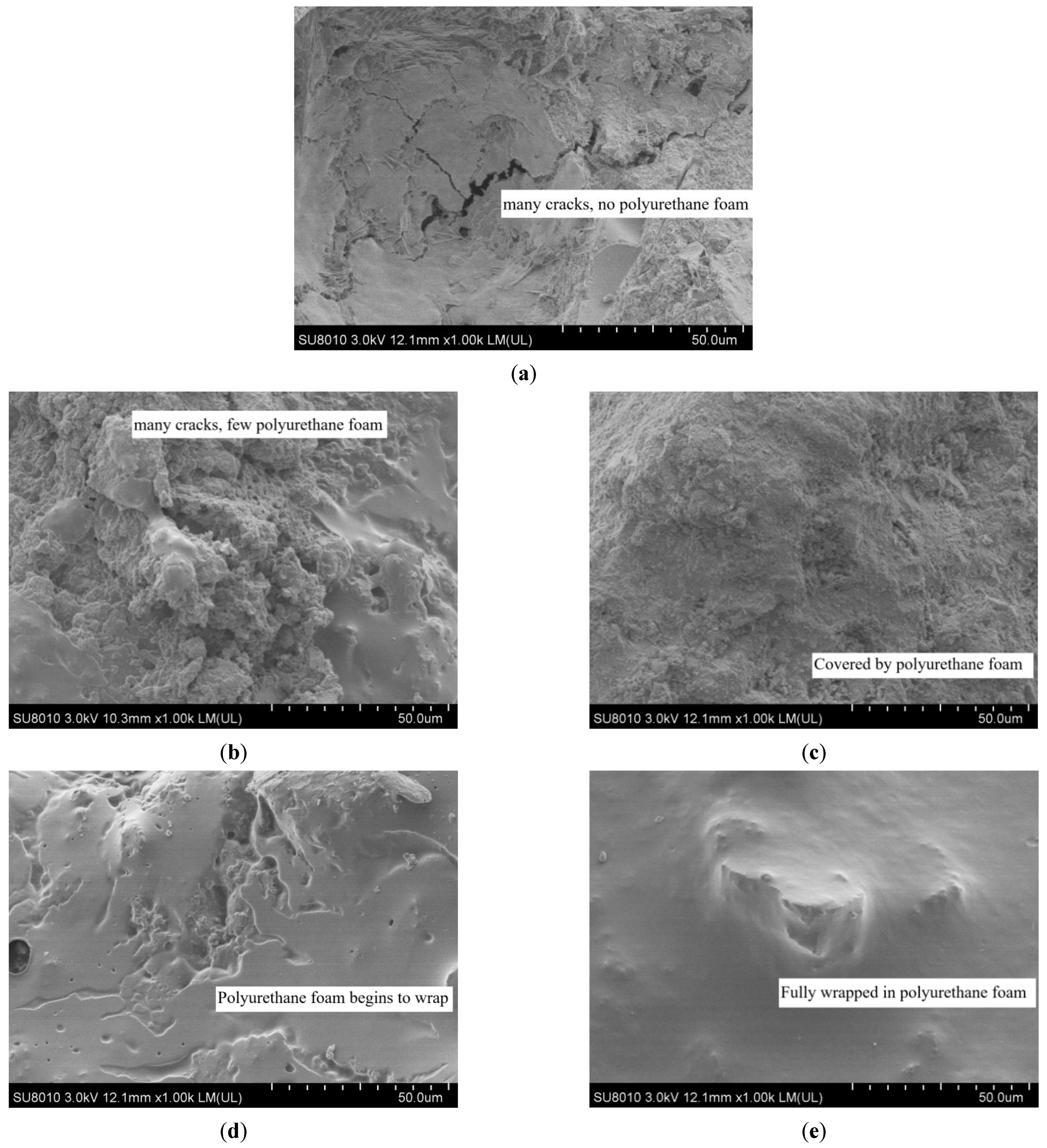
| Test Type | Characteristic Particle Size (mm) | Grading Parameters | |||
|---|---|---|---|---|---|
| D10 | D30 | D60 | Cu | Cc | |
| Large-scale direct shear test | 1.16 | 5.21 | 13.12 | 11.31 | 1.78 |
| CBR test | 0.55 | 1.9 | 4.5 | 8.18 | 1.46 |
| Scheme Types | Polyurethane Content (%) | Vertical Load (kPa) | Shear Rate (mm/min) |
|---|---|---|---|
| A | 0 | 30/60/90 | 1 |
| 1.5 | |||
| 3 | |||
| 4.5 | |||
| 6 | |||
| B | 6 | 30 | 0.5 |
| 1 | |||
| 2 | |||
| 5 |
| Polyurethane Content (%) | Peak Shear Stress (kPa)/Increase Ratio (%) | ||
|---|---|---|---|
| 30 kPa | 60 kPa | 90 kPa | |
| 0 | 49.1/0 | 91.3/0 | 136.2/0 |
| 1.5 | 61.0/24.2 | 107.3/17.5 | 154.6/13.5 |
| 3 | 76.9/56.6 | 124.8/36.7 | 171.5/25.9 |
| 4.5 | 109.3/122.6 | 157.8/72.8 | 203.9/67.7 |
| 6 | 145.4/196.1 | 193.1/111.5 | 242.6/78.1 |
Publisher’s Note: MDPI stays neutral with regard to jurisdictional claims in published maps and institutional affiliations. |
© 2022 by the authors. Licensee MDPI, Basel, Switzerland. This article is an open access article distributed under the terms and conditions of the Creative Commons Attribution (CC BY) license (https://creativecommons.org/licenses/by/4.0/).
Share and Cite
Ma, Q.; Li, J.; Huang, S.; Xiao, H. Analysis of Shear Resistance and Mechanism of Construction and Demolition Waste Improved by Polyurethane. Sustainability 2022, 14, 8180. https://doi.org/10.3390/su14138180
Ma Q, Li J, Huang S, Xiao H. Analysis of Shear Resistance and Mechanism of Construction and Demolition Waste Improved by Polyurethane. Sustainability. 2022; 14(13):8180. https://doi.org/10.3390/su14138180
Chicago/Turabian StyleMa, Qiang, Junhui Li, Shaoping Huang, and Henglin Xiao. 2022. "Analysis of Shear Resistance and Mechanism of Construction and Demolition Waste Improved by Polyurethane" Sustainability 14, no. 13: 8180. https://doi.org/10.3390/su14138180
APA StyleMa, Q., Li, J., Huang, S., & Xiao, H. (2022). Analysis of Shear Resistance and Mechanism of Construction and Demolition Waste Improved by Polyurethane. Sustainability, 14(13), 8180. https://doi.org/10.3390/su14138180





